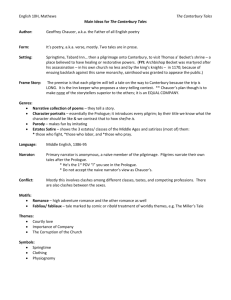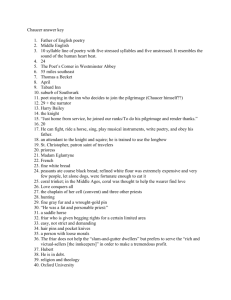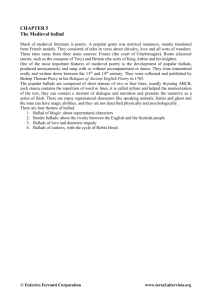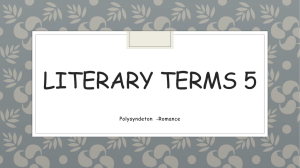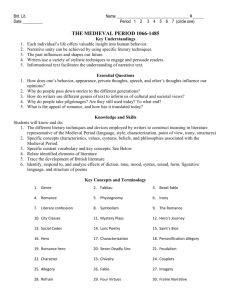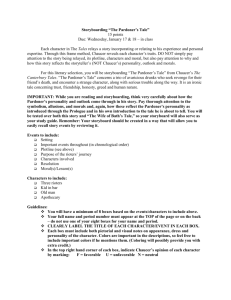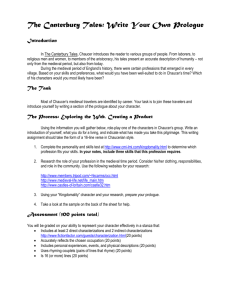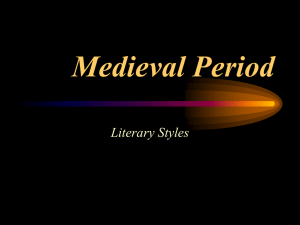Middle Ages Lesson Plans
advertisement
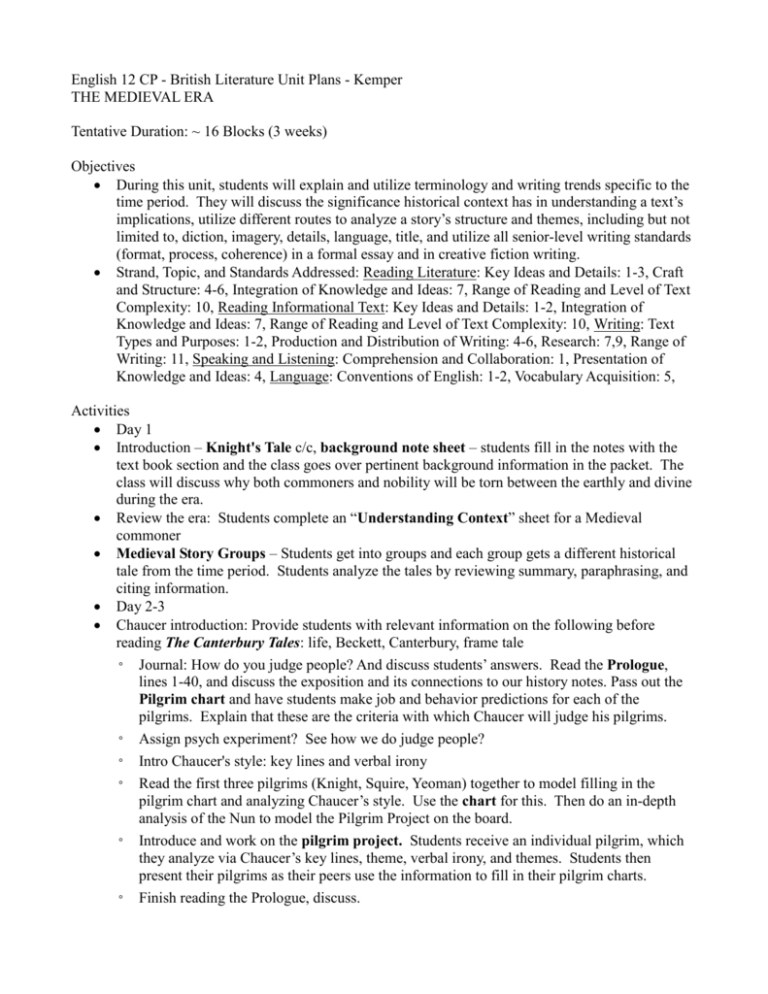
English 12 CP - British Literature Unit Plans - Kemper THE MEDIEVAL ERA Tentative Duration: ~ 16 Blocks (3 weeks) Objectives During this unit, students will explain and utilize terminology and writing trends specific to the time period. They will discuss the significance historical context has in understanding a text’s implications, utilize different routes to analyze a story’s structure and themes, including but not limited to, diction, imagery, details, language, title, and utilize all senior-level writing standards (format, process, coherence) in a formal essay and in creative fiction writing. Strand, Topic, and Standards Addressed: Reading Literature: Key Ideas and Details: 1-3, Craft and Structure: 4-6, Integration of Knowledge and Ideas: 7, Range of Reading and Level of Text Complexity: 10, Reading Informational Text: Key Ideas and Details: 1-2, Integration of Knowledge and Ideas: 7, Range of Reading and Level of Text Complexity: 10, Writing: Text Types and Purposes: 1-2, Production and Distribution of Writing: 4-6, Research: 7,9, Range of Writing: 11, Speaking and Listening: Comprehension and Collaboration: 1, Presentation of Knowledge and Ideas: 4, Language: Conventions of English: 1-2, Vocabulary Acquisition: 5, Activities Day 1 Introduction – Knight's Tale c/c, background note sheet – students fill in the notes with the text book section and the class goes over pertinent background information in the packet. The class will discuss why both commoners and nobility will be torn between the earthly and divine during the era. Review the era: Students complete an “Understanding Context” sheet for a Medieval commoner Medieval Story Groups – Students get into groups and each group gets a different historical tale from the time period. Students analyze the tales by reviewing summary, paraphrasing, and citing information. Day 2-3 Chaucer introduction: Provide students with relevant information on the following before reading The Canterbury Tales: life, Beckett, Canterbury, frame tale ◦ Journal: How do you judge people? And discuss students’ answers. Read the Prologue, lines 1-40, and discuss the exposition and its connections to our history notes. Pass out the Pilgrim chart and have students make job and behavior predictions for each of the pilgrims. Explain that these are the criteria with which Chaucer will judge his pilgrims. ◦ Assign psych experiment? See how we do judge people? ◦ Intro Chaucer's style: key lines and verbal irony ◦ Read the first three pilgrims (Knight, Squire, Yeoman) together to model filling in the pilgrim chart and analyzing Chaucer’s style. Use the chart for this. Then do an in-depth analysis of the Nun to model the Pilgrim Project on the board. ◦ Introduce and work on the pilgrim project. Students receive an individual pilgrim, which they analyze via Chaucer’s key lines, theme, verbal irony, and themes. Students then present their pilgrims as their peers use the information to fill in their pilgrim charts. ◦ Finish reading the Prologue, discuss. ◦ Students take the Pilgrim Quiz. ◦ Day 4 ◦ Analyze “The Pardoner's Tale” as a moral tale and for its literary elements. Students will read the story and judge it as a moral tale and the irony of it being told by the Pardoner. ▪ Students will complete a timed writing assignment which explains the infrerences made about the beliefs and actions of people during the era. ◦ View and discuss several other example tales (via the clay-mation version) : irony, foreshadowing, personification, and the morals taught ▪ Allegory: Character who personifies and abstract idea (death) ▪ Generalizations about humanity (humans turn on each other due to greed) ▪ Teaches a religious/moral lesson (greed is root of all evil) ▪ Symbols: What does the old man and the gold represent? ▪ Irony: What is the situational irony within the story? Why is it ironic the Pardoner tells it? ◦ In-Class Chaucer Essay – Students analyze Chaucer’s style and themes and use a rubric to evaluate their own writing in an in-class writing assignment. ◦ Chaucer’s Canterbury Tales Quiz – tests over both the Prologue and Pardoner’s Tale – 25 MC, 1 extended response. Day 5 The class will read the excerpt from “Everyman” together, establishing it as an allegory and discussing its themes. The class will then watch a “Mayhem” All State commercial in order to show how morality tales are used today. Students will individually analyze how the commercial fulfills the characteristics of an allegory, and then discuss how the roles of morality tales have changed for us today. The class will introduce ballads using the background information on p. 193. The teacher will ask students what topics they think would be addressed both in the Middle Ages and today. The class will read and discuss an example ballad, “The Cruel Sister.” The class will analyze its repetition, rhyme, meter, and insights it provides into daily life in the Middle Ages. Day 6 Ballads – Students review the ballad using p. 193, then read get into small groups to analyze one of the three ballads in the text book: “Sir Patrick Spens,” “Barbara Allen” and “Get Up and Bar the Door.” Students also make inferences to explain differences in courtly and common life. Each group is responsible for completing the Ballad Analysis Sheet for their ballad and sharing it out with the clas. Then students peruse National Enquirers/the internet for topic ideas and write modern-day ballads, revealing knowledge of characteristics and tendencies. Day 7 Pairs will receive time to work on and optionally share out their ballads. Discuss any differences in topics today versus the Medieval ballads we read. The class will introduce the elements of the Medieval Romance. The class will begin viewing The Princess Bride. Students are responsible for noting how the film fulfills (and makes fun of) the characteristics of a romance as they watch. Day 8-9 The class will finish viewing the movie and fulfilling romance characteristics. As the class views, they will also analyze and discuss the impact of the frame story and the use of archetypal characters. The class will also receive a Code of Chivalry to judge Wesley by. The movie will end with a timed writing assignment where the students can choose to explain how the movie makes fun of either the Romance itself or of the Code of Chivalry. Day 10-12 View the A&E King Arthur Video – students answer guiding questions to learn about the Arthurian legends, their truths, and what they reveal about beliefs and customs of the era. Review the Romance with the text book definition and the Quest excerpt from Foster’s book. Have students write down the 5 elements of a quest (apply it to Inego and Wesley) SGGK: Break down the reading into manageable parts. The overall goals of reading this story are to analyze it as a Medieval text that interacts with its context, as a Romance, as a Quest, and to compare and contrast it with other texts from the time period. The reading and activities go aas follows: ◦ 210-212: stump the teacher – students show their close reading skills ◦ 213-214: Using the chivalry handout, evaluate how well the Arthurian knights have proved themselves worthy of their reputation so far. ◦ 215-216: highlight the characteristics of a romance and quest shown in the story so far. ◦ 216-end: Students make a time line of events that includes evidence of the romance, quest, and chivalry (color coded?) -or- complete the selection open-book “test” worksheet (from the text book materials) ◦ SGGK project in partners, then present. The project reveals students’ understanding of universal themes, cultural context, author’s style, and character motivations. Day 13 Read and complete the packet pages for the excerpt from Margery Kempe. Provide time for any missing work/packet pages, and review before collecting them. Final review of the unit: small groups use their books, notes, and packets to review the main forms of literature for the time period: morality tales, ballads, autobiographies, allegories, and romances. They should create a visual that depicts the following for each form: ◦ definition and characteristics, example texts, purpose for writing, what social groups they related to, and insights provided into daily life/beliefs. Day 14 Final Assessment: Students choose to read another ballad, allegory, or romance. They will be responsible for summarizing the text, explaining what insights into Medieval life/culture/beliefs it provides, and comparing and contrasting it with the example of that literary form we read during the unit (“The Cruel Sister,” “Pardoner's Tale,” or “SGGK”)
